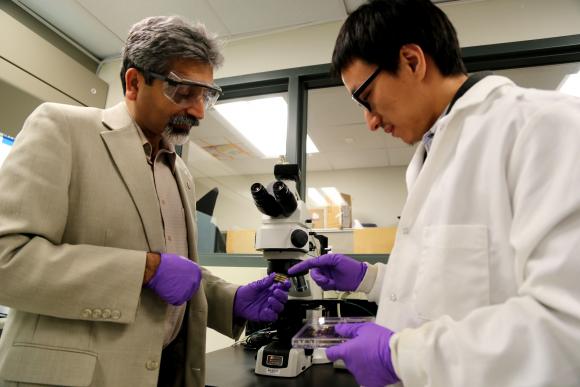PROVIDENCE, R.I. [Brown University] — A team led by Brown University researchers has been awarded $4 million by the National Science Foundation to study a promising new type of solar cell. The research, to be performed in partnership with the University of Nebraska–Lincoln (UNL) and Rhode Island College (RIC), will focus on solar cells made from perovskites, a class of crystalline materials.
“Perovskites have great promise for use in a variety of highly efficient, low-cost solar cells,” said Nitin Padture, professor in the School of Engineering and director of Brown’s Institute for Molecular and Nanoscale Innovation. “We want to understand better the basic science behind these solar cells, look for ways to develop new technologies based on that understanding, and investigate scalable production methods that could one day bring perovskite solar cells to market.”
Since they were first developed in 2009, perovskite solar cells have sent quite a jolt through the solar energy world. In just a few years, the efficiency with which lab-scale perovskite cells convert sunlight into electricity has soared. They’re now nearly as efficient as traditional silicon cells, but have the potential to be produced at a fraction of the cost. And perovskites can be easily made into thin films with vivid colors, which raises their potential for use in building-integrated solar cells like shingles, siding, or even windows that can generate electricity.
“It’s an exciting technology, but there’s still much more work that needs to be done before perovskite solar cells are widely available,” said Padture, who serves as the principal investigator on this new grant.
For example, scientists lack a complete understanding of exactly how perovskite cells work at the molecular level. Such understanding could help in improving efficiency of perovskite films and optimizing them for different applications.
It might also be possible, Padture says, to improve efficiency by combining perovskites with other materials and technologies. To explore all those possibilities, Padture’s lab will partner with several faculty researchers, including Kristie Koski of the Department of Chemistry at Brown; Angus Kingon, Domenico Pacifici, and Rashid Zia of the School of Engineering at Brown; Medini Padmanabhan of RIC; and Jinsong Huang, Xia Hong, and Xiao Zeng of UNL.
Another focus of the project will be looking for ways to scale up the production of perovskite films.
“The cells that people are making now are quite small,” Padture said. “Small cells are great for testing efficiency in the lab, but the process needs to be scaled up to bring products to market. Better understanding of the underlying materials science is key to addressing this challenge.”
Padture and his colleague have already made some progress on that front, and they hope to continue with this new grant. Earlier this year, Padture’s lab demonstrated a method for making high-quality perovskite films over relatively large areas at room temperature. Traditional methods for making films involve heat treatment, which can disrupt the film coverage when trying to make large films. The room-temperature method helps eliminate those defects and is more amenable to an assembly-line process.
“We hope to cultivate industrial partnerships to refine these kinds of techniques and help take this technology to the next level,” Padture said.
Another issue the researchers will look to address is the fact that the best performing perovskite solar cells contain some lead. The team will look for lead-free perovskite compositions that work equally well.
The grant also includes a substantial outreach and education effort, which will be led by Karen Haberstroh of Brown’s School of Professional Studies. Students and researchers involved in the project will go to middle and high schools to talk about energy efficiency and green technologies. The project also includes the development of an online college course on solar technologies aimed at people who are interested in entering the green workforce. The grant also provides funding for graduate students and for undergraduate research opportunities.
The award, which will be paid over four years, was made through the National Science Foundation’s Experimental Program to Stimulate Competitive Research (EPSCoR) program. This latest round of funding went to eight wide-ranging projects totaling $42 million and aimed at fostering research collaborations among investigators and institutions across 12 states.

